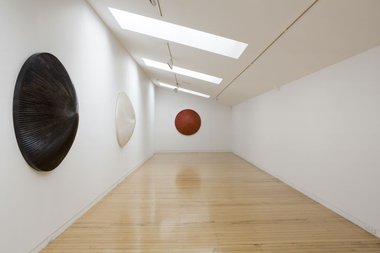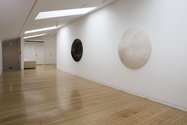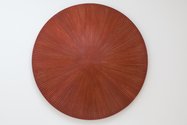John Hurrell – 14 May, 2012
Graham's use of dizzying visual velocity - you get vertigo when you focus on the fine detail - makes a lot of sense when you consider that these wall relief works are symbols for the terrible fast moving tsunamis that did catastrophic damage in Samoa, Chile and Japan. The bodily sensation these sculptures elicit is a variety of alarm, a small, gently churning panic at the confusion caused by the receding lines.
This new show from Brett Graham carries on the tradition of stained wood carving he became known for in the mid-nineties, when he made large freestanding abstract sculptures based on botanical or zoological forms using dynamic contours and delicate tactile surfaces - tying them in with Maori mythology and Maori concepts.
The three works upstairs at Two Rooms are like huge inverted saucers, covered with radiating grooves that converge in the centres. As if intricately carved, bulging Frisbees, their textures seem vaguely related to the fins of mushrooms or varieties of mound coral. Thin ‘Maori’ coloured lacquers (white, black and red) allow subtle marbled textures to peek through from underneath.
Yet for all their formal simplicity there is a conceptual sophistication here that dawns on you slowly. Each groove diminishes in thickness and depth as it advances towards the swelling middle away from the flatter outer edge, and seems to accelerate as it gets smaller.
Graham’s use of dizzying visual velocity - you get vertigo when you focus on the fine detail - makes a lot of sense when you consider that these wall relief works are symbols for the terrible fast moving tsunamis that did catastrophic damage in Samoa, Chile and Japan. The bodily sensation these sculptures elicit is a variety of alarm, a small, gently churning panic at the confusion caused by the receding lines. They physically advance towards you on the curved surface but as vectors, they retreat. They draw you in and then rush off to the distant vanishing point.
Their title, Tangaroa piri whare, refers to both Tangaroa the God of the sea and the first Maori carving - for according to legend, Tangaroa was offended by Manuruhi (son of Ruatepupuke) because he didn’t ask for permission to fish, nor did he make an offering in thanks. Subsequently he kidnapped him, turning him into a carved post with which to decorate his underwater house but the boy was later rescued by his angry father, and his release introduced the pleasures of carving to humanity.
Such directly visceral work is a surprise after Graham’s more cerebrally complex sculptures of recent years with cast iron versions of military hardware. His Russian / Maori armoured car was a hit at the last Sydney Biennale but this new work (referred to by the artist as ‘shields’ and named after Kesennuma, Talcahuano and Saanapu, badly hit towns in Japan, Chile and Samoa) has - I think - greater physical presence. Propelled by Graham’s steely wit and resolute compassion, the eyes lead the body, brain and mind into the accelerating distant maelstrom. For the viewer who likes to stand up close - and if you don’t you miss the point - it’s a particularly impressive project.
John Hurrell










 Advertising in this column
Advertising in this column Two Rooms presents a program of residencies and projects
Two Rooms presents a program of residencies and projects



This Discussion has 0 comments.
Comment
Participate
Register to Participate.
Sign in
Sign in to an existing account.